Click on images to enlarge
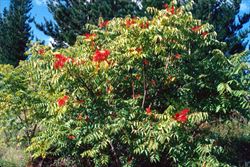
habit in fruit (Photo: Land Protection, QDNRW)

habit in flower (Photo: Trevor James)

a dense clump of plants developing from root suckers (Photo: Trevor James)
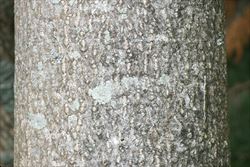
greyish bark on main trunk (Photo: Trevor James)

leaves (Photo: Sheldon Navie)

close-up of reddish-coloured young foliage (Photo: Trevor James)
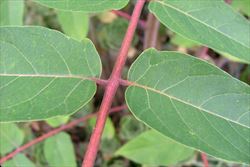
close-up of leaflets with small lobes at their bases (Photo: Sheldon Navie)

close-up of the underside of the leaflets, showing the raised glands (Photo: Trevor James)
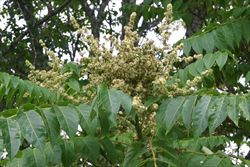
large flowers clusters (Photo: Trevor James)

male flowers (Photo: Trevor James)
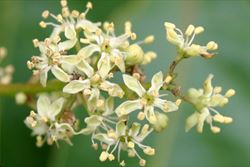
close-up of male flowers (Photo: Trevor James)
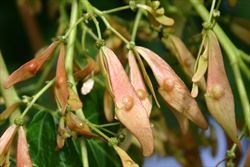
young fruit (Photo: Trevor James)

immature reddish-coloured fruit (Photo: Trevor James)
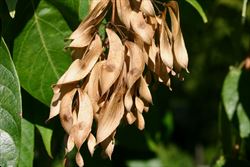
mature winged fruit (Photo: Trevor James)
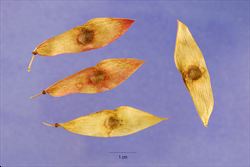
close-up of seeds (Photo: Steve Hurst at USDA PLANTS Database)

seedling (Photo: Sheldon Navie)

young root sucker (Photo: Trevor James)

root suckers removed from the ground (Photo: Trevor James)
Scientific Name
Ailanthus altissima (Mill.) Swingle
Synonyms
Ailanthus glandulosus Desf.Ailanthus rhodoptera F. Muell.Ailantus rhodoptera F. Muell., orth. var.Toxicodendron altissimum Mill.
Family
Simaroubaceae
Common Names
ailanthus, baked sewage tree, China sumac, Chinese sumac, Chinese tree of heaven, Chinese tree-of-heaven, copal tree, ghetto palm, kerosene tree, lacquer tree, rotting carrion tree, stink tree, stinking cedar, stinking shumac, stinktree, tree from hell, tree of heaven, tree-in-a-hurry, tree-of-heaven, varnish tree, varnishtree
Origin
Native to eastern Asia (i.e. north-eastern and central China).
Cultivation
Tree of heaven (Ailanthus altissima) has been widely cultivated as a garden and street tree in the temperate and cooler sub-tropical regions of Australia.
Naturalised Distribution
A widely naturalised species that is largely found throughout the coastal and sub-coastal regions of south-eastern Australia. It is most common in the coastal and sub-coastal regions of eastern New South Wales, in the ACT and in Victoria. Also relatively common or occasional in south-eastern South Australia, south-western Western Australia and south-eastern Queensland.
Naturalised overseas in Europe, Africa, New Zealand, the USA, Canada, Mexico, South America, the Azores and Hawaii.
Habitat
A weed of bushland, waterways, gullies, forest margins, pastures, forestry plantations, urban areas, abandoned homes, disturbed sites, waste areas, roadsides and railways in the humid and sub-humid temperate and sub-tropical regions of Australia.
Habit
Rarely a large shrub or more commonly a medium to large tree that loses its leaves in autumn (i.e. it is deciduous). It usually grows from 3 to 12 m tall, but may occasionally reach up to 25 m in height.
Distinguishing Features
- a large shrub or tree that loses its leaves during autumn.
- its once-compound leaves are very large (40-100 cm long), with 5-20 pairs of leaflets and a single leaflet at the tip.
- its leaflets are mostly entire, except for a few teeth or small lobes near the base which bear prominent raised glands.
- its small white or greenish-yellow flowers are borne in large spreading clusters at the ends of the branches.
- separate male and female flowers are produced on different plants.
- its distinctive winged fruit (3-5 cm long and 7-15 mm wide) turn bright reddish-pink or reddish-brown as they mature.
Stems and Leaves
The leaf-bearing, younger stems are smooth or pitted, speckled and reddish-brown in colour. Mature stems have grey or yellowish-grey coloured bark that is slightly rough in texture.
The stalked (i.e. petiolate) leaves are very large (40-100 cm long) and alternately arranged along the stems. These leaves are once-compound with 5-20 pairs of leaflets a single terminal leaflet (i.e. they are imparipinnate). Individual leaflets are narrowly oval (i.e. elliptic), egg-shaped in outline (i.e. ovate), or slightly elongated in shape and are borne on short stalks (i.e. petiolules). These leaflets (4-15 cm long and 1.5-6 cm wide) are hairless (i.e. glabrous) or sparsely hairy (i.e. puberulent). Their margins are mostly entire, except for a few teeth or a small lobe near the base of the leaflet, and their tips taper to a point (i.e. they have acuminate apices). There is one or more prominent raised glands on the underside of each leaflet, near the basal teeth or lobe. Leaves turn yellow and are lost during the autumn (i.e. it is deciduous), and new bright green leaves are produced in mid-spring.
Flowers and Fruit
The small flowers are borne in large spreading clusters (up to 60 cm long) at the tips of the branches (i.e. in terminal panicles). They are white or greenish-yellow in colour with five small petals (2-4 mm long), and five tiny sepals (i.e. calyx lobes) that are only 0.75-1 mm long. Separate male and female (i.e. unisexual) flowers are produced on different plants and the male flowers produce a very strong smell (i.e. they are very pungent). Flowering occurs during late spring and summer.
The winged fruit (i.e. samara) are initially yellow or greenish in colour but turn reddish-pink or reddish-brown as they mature. These fruit consist of a rounded disc containing the seed (3-4 mm across) and a large flat wing (3-5 cm long and 7-15 mm wide). The fruit begin to develop in late summer and early autumn, but can remain on the tree into winter.
Reproduction and Dispersal
This plant reproduces by seed and also produces large numbers of suckers from its shallow roots, especially after the main stem is cut down.
The seeds are mostly spread by wind and water, and these forms of dispersal are aided by their wings. They can also be dispersed by birds, machinery, mowers, and in dumped garden waste. Colonies also spread laterally over time, via the root suckers.
Environmental Impact
Tree of heaven (Ailanthus altissima) is regarded as an environmental weed in New South Wales, the ACT, Victoria, South Australia, Queensland and Western Australia. It was recently also listed as a priority environmental weed in two Natural Resource Management regions. This species primarily occurs in disturbed areas, but its winged seeds can blow considerable distances and it may also invade undisturbed habitats. It spreads into bushland from old homestead sites and other plantings, and is particularly invasive in riparian vegetation and along gullies. However, it can also invade dry sclerophyll forests and other woodlands.
This species is an aggressive competitor due to its suppression of other plants with toxins (i.e. allelopathic chemicals) and the abundant suckers that it produces from its shallow roots. Tree of heaven (Ailanthus altissima) is also a very successful competitor for both light and nutrients, and typically shades out other species with its very large and dense leaves. The root suckers enable the plant to develop into extensive thickets, sometimes many hectares in size, that displace the native vegetation. These stands can be almost devoid of other species (i.e. monospecific) and can remain for long periods of time. It also re-sprouts vigorously when cut or damaged, making its eradication extremely difficult and time consuming.
Tree of heaven (Ailanthus altissima) is probably of most concern in the warmer temperate regions of eastern New South Wales, and is actively managed by community groups in these areas. It appears on numerous local and regional environmental weed lists (e.g. in the North Coast region, the Hunter and Central Coast region, the wider Sydney and Blue Mountains region, and the South Coast region) and has also been recorded in many conservation areas (e.g. in the Ellerslie Nature Reserve in Gundagai Shire, in the Koorawatha Nature Reserve in Young Shire, in Bournda National Park in Bega Valley Shire, in Cuumbeun Nature Reserve in Queanbeyan City, in Deua National Park in Eurobodalla Shire and in the Severn River Nature Reserve in Inverell Shire) in these parts of New South Wales.
Tree of heaven (Ailanthus altissima) is also regarded as a threat to the survival of the endangered obcordate-leafed zieria (Zieria obcordata), which is restricted to a handful of populations in the inland parts of central New South Wales. The largest of these populations, which is located near Wellington, has a major infestation of tree of heaven (Ailanthus altissima) growing in and around the core habitat area of obcordate-leafed zieria (Zieria obcordata). If not controlled, it is thought that this weed is likely to overtake the rocky outcrop vegetation in which obcordate-leafed zieria (Zieria obcordata) occurs, out-competing it and other native species in this area.
This species is also a significant problem in other parts of south-eastern Australia. Tree of heaven (Ailanthus altissima) is regarded as a potential threat to one or more vegetation formations in Victoria. It occurs mainly in the northern and western parts of this state, and is listed as an environmental weed in the Goulburn Broken Catchment region. This species is also a common environmental weed of plains and hills in the Adelaide region in South Australia. For example, it is regarded as an invasive plant in bushland in the Adelaide Hills Council District and has been recorded in the Anstey Hill Recreation Park.
Tree of heaven (Ailanthus altissima) is also ranked among the top 200 most invasive plant species in south-eastern Queensland, however it mainly casues problems in the cooler highland parts of this region. It has also spread from gardens and old settlements in the southern wheatbelt region in south-western Western Australia.
Overseas, tree of heaven (Ailanthus altissima) is is listed in the Global Invasive Species Database and is an important environmental weed in the USA. This species is found throughout most of the US, where it overruns native vegetation and also causes damage to sewers and foundations in urban areas.
Other Impacts
The bark, leaves and flowers of this species are poisonous to humans and livestock, and it is also known to cause contact dermatitis in humans.
Legislation
This species is declared under legislation in the following states and territories:
- ACT: C4 - prohibited - a pest plant whose supply is prohibited in the ACT.
- New South Wales: Class 4 - a locally controlled weed. The growth and spread of this species must be controlled according to the measures specified in a management plan published by the local control authority and the plant may not be sold, propagated or knowingly distributed (in a large number of local authority areas). See the New South Wales Department of Primary Industries Noxious Weeds List at http://www.dpi.nsw.gov.au for more detailed information on which local areas are covered in these declarations.
- Victoria: C7 - a regionally controlled weed in the Glenelg, Corangamite, Port Phillip West, Port Phillip East, Goulburn, North East and East Gippsland regions. Landholders must take all reasonable steps to control this species and prevent its spread on their land and the roadsides which adjoin their land in these regions.
- Western Australia: Unassessed - this species is declared in other states or territories and is prohibited (throughout the entire state) until assessed via a weed risk assessment.
Management
For information on the management of this species see the following resources:
- the Tree of Heaven page on the South Coast Weeds website at http://www.esc.nsw.gov.au/Weeds/index.asp.
Similar Species
Tree of heaven (Ailanthus altissima) can sometimes be confused with rhus (Toxicodendron succedaneum). These species can be distinguished by the following differences:
- tree of heaven (Ailanthus altissima) has leaves that turn yellow in colour before they are shed. Its winged fruit (i.e. samaras) are relatively large (3-5 cm long) and turn reddish in colour as they mature.
- rhus (Toxicodendron succedaneum) has leaves that turn bright reddish in colour before they are shed. Its somewhat rounded berry-like fruit (i.e. drupes) are relatively small (5-10 mm across) and turn dark-brown in colour as they mature.
Two native trees, red cedar (Toona ciliata) and pencil cedar (Polyscias murrayi), are also easily confused with tree of heaven (Ailanthus altissima) as they have very similar leaves. However, neither of these native trees have glands on the base of their leaflets, and pencil cedar (Polyscias murrayi) does not lose its leaves during autumn (i.e. it is evergreen). Also, the fruit of red cedar (Toona ciliata) is a dry capsule (1-2 cm long) which splits open to release four or five winged seeds, while the fruit of pencil cedar (Polyscias murrayi) is a small purple 'berry' (i.e. drupe) about 4 mm across.

